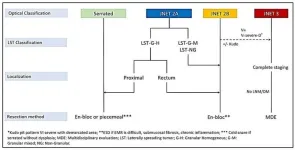(Press-News.org) PITTSBURGH, April 22, 2024 – Atrial fibrillation (Afib), a common type of arrhythmia that is on the rise in people under the age of 65, is more dangerous in this increasingly younger population than previously thought, according to a new study published today in Circulation Arrhythmia and Electrophysiology and authored by physician-scientists at the UPMC Heart and Vascular Institute.
The study, which is among the first to examine a large group of Afib patients younger than 65 in the U.S., found that these younger patients were more likely to be hospitalized for heart failure, stroke or heart attack and had significantly higher rates of comorbidity and mortality, compared to similarly aged and gender-matched people who do not have Afib.
“Common knowledge among cardiologists is that, in people under 65, Afib is extremely uncommon and not detrimental. But there really hasn’t been any data to back that up,” said lead author Dr. Aditya Bhonsale, M.D., M.H.S, a UPMC cardiac electrophysiologist in HVI’s Division of Cardiology who is also an assistant professor of medicine at the University of Pittsburgh.
“At UPMC, we've been seeing a lot more young patients with Afib in recent years and have been interested in understanding the real-world clinical course of these individuals. As a payer-provider with patient records across more than 40 hospitals, UPMC was uniquely positioned to ask this question, which no one has been able to ask before,” Bhonsale added.
Drawing from the electronic health records of 67,221 UPMC patients seeking care for Afib from 2010 through 2019, the researchers found that more than a quarter of them (17,335) were under the age of 65, a stark contrast to the 2% prevalence commonly estimated. The high proportion likely reflects an increasing burden of cardiovascular risk factors in younger Americans, said Bhonsale.
The UPMC team found that over the course of a decade, survival rates for those with the arrythmia were 1.3 to 1.5 times worse for men with Afib, and 1.82 to 3.16 times worse for women, compared to similarly aged patients who did not have Afib. The patients studied also had high rates of cardiovascular disease risk factors, including smoking, obesity, hypertension and sleep apnea, which contribute to damaging structural and electrical changes in the heart over time.
“We are optimistic that data from this study will foster future investigation to evaluate optimal therapies for patients with Afib,” said senior author Sandeep Jain, M.D., director of cardiac electrophysiology in HVI’s Division of Cardiology who is also a professor of medicine at the University of Pittsburgh.
Other authors on the study were Jianhui Zhu Ph.D., Floyd Thoma, Steve Koscumb, Krishna Kancharla, M.D., Andrew Voigt, M.D., Jared Magnani, M.D., N. A. Estes, M.D., Samir Saba, M.D., Oscar Marroquin, M.D., and Suresh Mulukutla, M.D., all of UPMC.
# # #
About UPMC
UPMC is a world-renowned, nonprofit health care provider and insurer committed to delivering exceptional, people-centered care and community services. Headquartered in Pittsburgh and affiliated with the University of Pittsburgh Schools of the Health Sciences, UPMC is shaping the future of health through clinical and technological innovation, research, and education. Dedicated to advancing the well-being of our diverse communities, we provide more than $1 billion every year in community benefits, more than any other health system in Pennsylvania. Our 100,000 employees — including more than 5,000 physicians — care for patients across 40 hospitals and 800 doctors’ offices and outpatient sites in Pennsylvania, New York, and Maryland, as well as overseas. UPMC Insurance Services covers more than 4 million members with a focus on providing the highest-quality care at the most affordable price. To learn more, visit UPMC.com.
www.upmc.com/media
END
Researchers who study Earth’s biosphere tend to operate from one of three scientific cultures, each with distinct ways of conducting science, and which have been operating mostly independently from one another, find the authors of a Perspective published in PNAS on April 19, 2024. SFI Professors Christopher Kempes and Geoffrey West, together with External Professor Brian Enquist (University of Arizona) identify and explain the three cultures, and suggest that reconnecting them could help accelerate ...
Colorectal cancer (CRC) is the second most common cancer in the United States. This highlights the importance of early detection and treatment of precancerous lesions like large polyps. Endoscopy offers a minimally invasive approach to removing these polyps, reducing the need for traditional surgery.
This review, published in eGastroenterology, explores advancements in endoscopic resection techniques, specifically Endoscopic Mucosal Resection (EMR) and Endoscopic Submucosal Dissection (ESD).
Complete removal of large polyps (>10 mm) is crucial to prevent progression to CRC. Piecemeal resection during endoscopic procedures can increase the risk ...
The Speech Accessibility Project, which aims to make automatic speech recognition technology more accessible to people with speech differences and disabilities, is now sharing some of its voice recordings and related data with universities, nonprofits and companies.
The project team is accepting signed data use agreements and one-page proposals for 211 recordings of people with Parkinson’s. The download also includes text of the original speech prompts and a transcript of the participants’ responses. A subset includes annotations ...
DALLAS, April 22, 2024 — Scientific researchers in Missouri and Virginia have been awarded nearly $1.4 million each in grants to study ways to extend the life expectancy and improve the quality of life for children with a transplanted heart. These two research awards mark the latest round of funding for a joint $3 million scientific research initiative between the American Heart Association, celebrating 100 years of lifesaving service as the world’s leading nonprofit organization focused on heart and brain health for all, and Enduring Hearts, the only non-profit organization solely dedicated ...
A University of Melbourne researcher has spotted a rare evolutionary phenomenon happening rapidly in real time in bats living in the Solomon Islands.
Dr Tyrone Lavery reports in a paper published in Evolution that two groups of leaf-nosed bats with vastly different body sizes that were thought to be separate species are an example of a rare type of parallel evolution. Parallel evolution is when different populations living in similar environments evolve similar features independently.
The smaller bat, Hipposideros diadema, is found across its six main islands and many smaller islands. It is ...
The SARS-CoV-2 virus that causes COVID has the unsettling ability of often generating variants of itself. Other viruses also mutate, but as SARS-CoV-2 quickly spread throughout the entire human population during the pandemic, killing millions, the virus’ dynamic evolution posed a serious problem: it repeatedly challenged our bodies’ immune response fighting the virus and hindered the process of getting updated vaccines ready.
Understanding the genetic mechanism fueling SARS-CoV-2’s ability to generate variants can go a long way in keeping COVID at bay. In this study published in Nature Microbiology, researchers at Baylor College of Medicine and collaborating institutions developed ...
Governments in the Mesoamerican Reef region are exploring the use of nature-based solutions to strengthen coral health and societal benefits for coastal communities. A new study led by Stanford researchers in collaboration with scientists from the World Wildlife Fund, the Healthy Reefs Initiative, and others from the Smart Coasts project quantified the outcomes of different watershed interventions to support coral health at regional versus national scales, and identified target areas that could improve both ecosystem and societal benefits nationally and across the region.
The nature-based approaches evaluated as key ...
An international team led by researchers at the University of Toronto has mapped the movement of proteins encoded by the yeast genome throughout its cell cycle. This is the first time that all the proteins of an organism have been tracked across the cell cycle, which required a combination of deep learning and high-throughput microscopy.
The team applied two convolutional neural networks, or algorithms, called DeepLoc and CycleNet, to analyze images of millions of live yeast cells. The result was a comprehensive map identifying where proteins are located and how they move and change in abundance ...
Physical cues in the womb, and not just genetics, influence the normal development of neural crest cells, the embryonic stem cells that form facial features, finds a new study led by UCL researchers.
The study published in Nature Cell Biology found that an increase in hydrostatic pressure sensed by the embryo can hinder the healthy development of facial features in mouse and frog embryos and in human embryoids (cell structures grown in the lab from human stem cells), suggesting that differences in pressure might affect the risk of facial malformations.
The ...
Artificial intelligence (AI) can quickly and accurately predict the path and intensity of major storms, a new study has demonstrated.
The research, based on an analysis of November 2023’s Storm Ciaran, suggests weather forecasts that use machine learning can produce predictions of similar accuracy to traditional forecasts faster, cheaper, and using less computational power.
Published in npj Climate and Atmospheric Science, the University of Reading study highlights the rapid progress and transformative potential of AI in weather prediction.
Professor Andrew Charlton-Perez, ...


